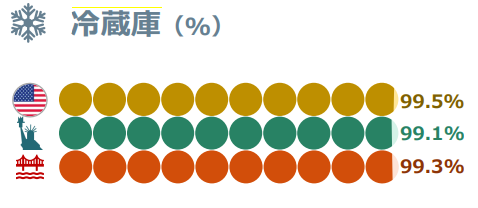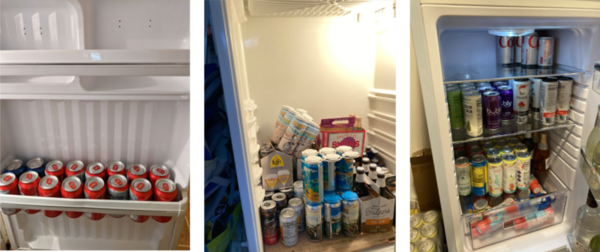[US]A refrigerator exclusively for fathers? What is the unique way of using a refrigerator in the U.S.?
- Release date: Aug 05, 2025
- Update date: Aug 05, 2025
- 2051 Views
Refrigerators are a necessity in our daily lives. In the United States, more than 90% of households own refrigerators.
How do American households use refrigerators? Are there any differences from Japan?
In this article, we will focus on the contents and placement of refrigerators and describe examples of how they are used, based on photos of actual homes of consumers in the “Consumer Life Panorama (CLP),” INTAGE's visual database for people living overseas.
What is Consumer Life Panorama?
This is a website-type database that has accumulated visual data on more than 1,000 sei-katsu-sha from 18 countries around the world. The database includes many 3D models of living environments and 2D data of items owned by each sei-katsu-sha, and is useful for understanding overseas sei-katsu-sha, which is difficult to grasp using only letters and numbers.
Using visual data such as those cited in this column,
Compare the differences in the attributes of overseas consumers
To get a realistic understanding of the actual usage of each category
To understand the overall lifestyle of target consumers
etc., can be utilized as a “no-go” home visit survey.


Household ownership of refrigerators in the U.S. exceeds 90%.
(Source: INTAGE Survey Report “Values Seen in the Homes of American Sei-katsu-sha” (issued June 30, 2023))
Kitchen cupboards that fit perfectly with the refrigerator
Detached houses in the U.S. are generally larger than those in Japan (about 2.7 times larger than those in Tokyo), and tend to be designed with wide open spaces throughout the house. In addition, because of strict regulations regarding newly built houses, used houses are said to account for about 80% of the market. For this reason, many households are remodeling their kitchens or doing DIY. The overall layout of the kitchen, cupboards, and other design elements are customized according to the needs and preferences of each household (mainly mothers), and space is also provided for a refrigerator. In many cases, other appliances such as stoves, ovens, dishwashers, and microwave ovens are installed in advance, with space for built-in appliances to be fitted.

(左)周囲の戸棚と同じデザインに統一したビルトインタイプ冷蔵庫
(右)冷蔵庫のサイズにぴったり合わせた戸棚
出典:インテージConsumer Life Panorama
Refrigerator for drinks only?
In addition to one refrigerator in the kitchen, some households have two refrigerators, one in the garage and one in the basement.
The second refrigerator is used for a variety of purposes depending on who is using it, such as “in the basement to store alcohol for dad to enjoy while watching football,” or "in the garage to store frozen food bought in bulk and stocked with ingredients. The second unit is used for a variety of purposes depending on who is using it and its purpose.

(Photo) Example of use as a dedicated beverage
Source: Intage Consumer Life Panorama
What's in the fridge?
What are the trends in refrigerator usage? The first characteristic that can be seen from the CLP photos is the large size bottles of condiments and beverages. Many of these bottles are quite large compared to those in Japan, and they occupy a lot of space in the refrigerator.
In some cases, these bottles are stored in the door pockets, but as if that is not enough, many households seem to stand the bottles up in the main space in the center as well. It is assumed that this may create dead space and make it difficult to smoothly put items in and out of the refrigerator.

(Photo) Seasonings and beverages placed in the door pocket. The size of the drinks seems to be larger than in Japan.
Source: INTAGE Consumer Life Panorama

(Photo) Beverages placed upright in the main space.
Source: INTAGE Consumer Life Panorama
Foods sold in the U.S. (especially those in bottles, such as seasonings and beverages) are large in size, so rather than dividing the refrigerator storage shelves into smaller sections, it may be better to have some wide, freely available space for versatility in utilization.
At the end.
In the refrigerator in the kitchen, which is the main space in American households, there was a tendency to store more beverages, seasonings, and processed foods than fresh food in many cases. We believe that we were able to catch a glimpse of the differences in the ingredients that are often stored in refrigerators, the size of their packages, and their uses, depending on the country.
We hope this column will help you understand the American consumer.
Reference Article:Values as seen through the homes of American Sei-katsu-sha (Virtual Home Tour)
-

Author profile
***
Engaged in marketing research support for major FMCG and DCG manufacturers (food, beverages, alcohol, miscellaneous goods, cosmetics, etc.), regardless of whether they are Japanese or foreign-affiliated companies.
The company publishes the results of its survey on “housework done by married men” on its website and other external media. -

Editor profile
Risa Takahama
After working in marketing research support for Japanese FMCG manufacturers (cosmetics, baby products, food and beverages, etc.) in Asia, Europe, and the U.S., from 2019, in his current position, he develops solutions for overseas marketing research for Japanese companies and conducts seminars and other outward communications.
 Global Market Surfer
Global Market Surfer CLP
CLP